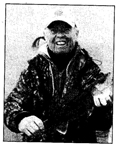 WineMaker's Report: Tom Holler Memorial Vintage 2013
WineMaker's Report: Tom Holler Memorial Vintage 2013 WineMaker's Report: Tom Holler Memorial Vintage 2013
WineMaker's Report: Tom Holler Memorial Vintage 2013by Mark Holler
My favorite Uncle, Tom Holler, went to the hallowed hunting grounds in the sky this unlucky year which inspired me to make a special vintage in his honor. The wine has turned out to be exceptional as was he.
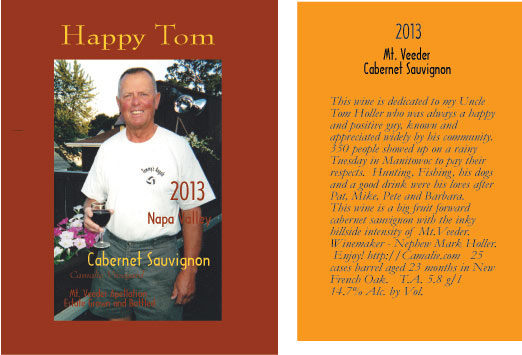
Below is a collage of pictures of Happy Tom.
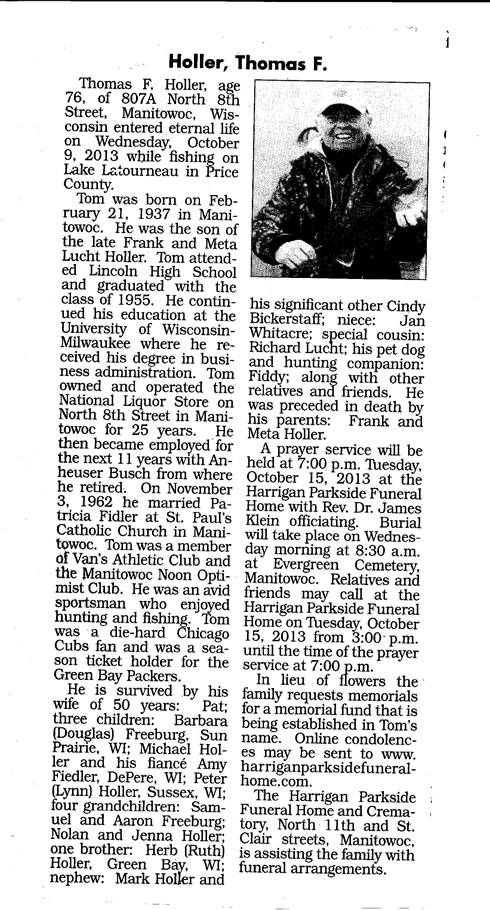
Here's a picture of the Malbec at Konrad Vineyards just before harvest.
Here you can see the much more frequent wine analysis for sulfites and additions which are having a major impact on the wine.
Wine analysis 2015-12-30-045-Prelim
Wine analysis 2015-09-11-055-Final
7/17/15 Got wine analysis2015-07-14-002-Final back and made sulfite additions to all 8 barrels. See notebook.
7/18/15 Bottled all 2013 Cab.
T4 Camalie Cab 298 bottles
RC6 Crouse Cab 76 bottles
RC8 Konrad Cab 148 bottles
WineAnalysis2015-02-04 done indicating sulfite additions are overdue, Crouse and Konrad alcohol levels are very high too.
1/25/14 We had our barrel mix tasting party. Attendance was good with 15 tasters total. Here are the scores. We had a first time tasting of all three vineyards we farm together with owners in attendance.
| Wine | Score | Place | |
| Camalie C.S. 25%: Malbec 75% | 10 | 1 | |
| Carmenere 60%: Camalie 2007 Merlot 40% | 10 | 1 | |
| Camalie C.S. 75%: Malbec 25% | 8 | 2 | |
| Camalie C.S. 100%: | 8 | 2 | |
| Crouse C.S. Bk. 6 100% | 8 | 2 | |
| MontGras 2010 Carmenere; Chile | 7 | 3 | |
| Konrad Malbec 100% | 7 | 3 | |
| Konrad C.S. 100% | 7 | 3 | |
| 46% Camalie: 33% Konrad: 20% Crouse all C.S. | 6 | 4 | |
| Konrad C.S. 66%: Malbec 33% | 4 | 5 |
Conclusions I draw from this are that blending Mabec into the Camalie Cab improved it and we should do a blend of 25% Camalie Cab with 75% Malbec. We didn't like Malbec with the Konrad Cab, but, my notes indicate there were some lies in this blend. In some cases I drew wine from the bottom of the barrels with the long thief which may have influenced the results. The Konrad cab had noticeably more tannins which may have contributed to its lower score at this time. Later in its life this will be a plus.
Blending Plan: Put 25% of the Camalie Cab into the Malbec barrel, put 25% of the 3 vinyeards cab into the Camalie Barrel and put 25% of the Malbec into the 3 Vineyards barrel. This will be done at the next racking which should be some time in the next couple months.
I think the Carmenere:Merlot blend did well mainly because of the aged Merlot in it.
1/24/14 Moved Carmenere to 10l carboy and topped with 2007 Merlot. Now blend is 60% carmenere:40% Merlot.
12/29/13 Tasted from barrels with Tom Mercen. No sign of residual sugar in flavor or effervescence. Looks like the fermentations finished cleanly.
11/25/13 Topped all barrels. Tasted with Duane, Julie and Anjanette, still some sweetness and effervescence.
11/9/13 Racked wine from tanks to barrels, with Pat and her sister to help.
| Barrel | Wine | Volume gal. |
| RC5 | Crouse Block 6 Cab. | 22 |
| RC4 | Konrad Block K2U Cab. | 26 |
| LG3 | Camalie Block 1 Cab. | 60 |
| T1 | Konrad Malbec | 60 |
| TR1 | Three Vineyards Cab. 46% Cam:33%Kon:20%Crouse |
60 |
11/4/13 Wine Analysis done today, numbers below. Very high acidity and very high alcohol. The tannins are moderate and the color inky as usual. The vines out did themselves this year. Residual sugars are on the high side indicating that the fermentations are not quite complete. Taste wise sugar levels have dropped since the pressing when we could taste sweetness in the wine distinctly. Now the sugar levels are low enough that they are not obvious. Target RS level is .2% although I measured a couple older wines including the 2005 and got .3% residual sugar. I would like to add some water to make sure the fermentations finish cleanly as the yeasts give up around 17% alcohol. There are other reasons to add water, see below.
We have very high pH in several of the wines in spite of the very high titratable acidities. This is dangerous especially with the wines in tank where they are exposed to a fair amount of air. They could easily develop a volatile acidity problem ( a vinegar concentration). As a result I would like to get the wines into barrel as soon as possible. The plan is to rack to barrels this coming Saturday 11/9/13.
This situation presents a couple challenges. The first is how much water to add to the wines. Normally a conventional winemaker would water them down or dealcoholize them to an alcohol level in the range 14.5-15.5%. We have excess acidity so we would definitely water back even if we could afford to dealc the wine. A reduction of the alcohol to around 15% would require about a 10% dilution of the wine which would bring the acidities down by about .7g/l to around 6.7g/l which would be good.
I would appreciate some input from co-op members on the dilution plan. We can leave the wine as is and make some rocket fuel wine or water back to the more normal tried and true range. We can also do some of each since we will have the wine in 4 different barrels. However we kind of want to keep the wine from different vineyards separate and have more than one Malbec blend which gets hard to fit in 4 vessels. We can also use two half barrels instead of a full barrel and end up with 5 vessels. Anyway send me your thoughts or not. Personnaly I don't like high alcohol because limits how much wine I can taste or drink. I drink more to enjoy the flavor than to get enebriated or at least I would like to think so. Still alcohol levels on the high side to reflect the character of the year sounds right.
We have just shy of 4 barrels of wine which will end up being 3.5 barrels plus a half barrel of topping wine, just about exactly what we were targeting. The co-op is now 66% subscribed which is a record. People realize it is a good year.
I also plan to innoculate for the malolactic fermentation tomorrow.
| Tank | Vol. gal. | Origin | T.A. g/l | pH | alcohol % by vol. | Residual. Sugar % | target alcohol | percent dilution | Water addition | expected T.A. g/l |
| A | 36 | Konrad | 7.45 | 3.8 | 16.5 | .6 | 15.5 | 6 | 2.1 gal. | 7.0 |
| B | 34.6 | Crouse | 7.35 | 3.77 | 16.8 | .4 | 15.8 | 6 | 2.1 gal. | 6.9 |
| C | 50 | Malbec | 7.85 | 3.57 | 16.1 | .4 | 15.0 | 7 | 3.5 gal. | 7.3 |
| E | 42.8 | K/Ca/Cr 44/44/12% | 7.85 | 4.04 | 16 | .6 | 14.5 | 9 | 3.8 gal. | 7.1 |
| F | 70.2 | Camalie | 7.2 | 4.15 | 15.7 | .5 | 15.1 | 4 | 2.8 gal. | 6.9 |
| Total | 233 | 14.3 |
Two weekends in here somewhere we pressed the wine off the skins.
10/19/13 Sorry for the big gap before this entry but, harvest activity went into overdrive after the last post and is finally finished now.
Here is a summary of the wine we now have in the tanks ready for pressing and its fermentation state.
| Tank | Volume (gal.) Post water addition | Source | Varietal | Harvest Date: | Specific Gravity 10/18/13 | Harvest Brix in Tank pre water addition | T.A. g/l | pH | Water Addition gal. | |
| A | 51 | Konrad- K2U | C.S. | 9/28 morning | 1005 | 29.1 | 9.6* | 3.6 | 4.3(8.5%) | |
| B | 50 | Crouse- Orleans | C.S. | 9/28 later | 996 | 28.4 | 9.5* | 3.5 | 2.4(5%) | |
| C | 60 | Konrad | Malbec | 9/7 | 995 | 25.6 | 3.36 | 0 | ||
| D | 48 | Camalie-Blk. 1 | C.S. | 10/5 | 1116 | 26.4 | ||||
| E | 32 | Konrad/Crouse 25/7 | C.S. | 9/28 | 1010 | 28.9 | 2.1(7%) | |||
| F | 56 | Camalie-Blk. 1 | C.S. | 10/5 | 1013 | 26.1 | 7.5 | 4.1 | 0 | |
| I | 34 | Camalie-Blk. 1 | C.S. | 10/5 | 1003 | 25.6 | 0 | |||
| J | 4 | Camalie | Carmenere | 10/5 | 1001 | 26.7 | 0 | |||
| Total | 335 |
* Samples taken 8 days earlier were in active fermentation. Samples were pumped down. Pre sulfite samples.
Brix levels this year were very high early this year and required some watering back to insure the fermentations complete and to keep the alcohol under 15%. Acidities are high also this year for some reason. Maybe the vines just kept producing more acid after they had maxed out on sugar production.
Below are the last half of the fermentation tank temperatures. The sharp drops are punch downs which homogenize the temperature in the tank. The temp sensors are placed in the middle of the cap. You can see that our fermentations never got very hot which means that we pulled less tannin out of the skins than if we had fermented at higher temps. This will make the wine more approachable in the near term.

9/14/13 The Specific gravity is down to 1060 indicating the fermentation is about half done. The temp is up to 75 F. Not too hot by any means. I would like it to go to 85F but, not without some form of heating will it get there. The fermentation mass is too small and the metal tank too conductive to let it get that high. The low temp ferment just means we won't get as much tannin out of the grapes. Since the ferment is already very dark I am not worried in the least about having low tannin in the finished wine. The wine should have softer tannins and be drinkable sooner.
9/13/13 I reconnected my fermentation temperature and C02 monitors, but the temps went offline a day or two later. Need to figure out what happened.
9/11/13 The Concerto yeast is bogus. The specific gravity of the must actually rose 3 points after 2.5 days indicating no fermentation at all. I called up Gusmer to get my money back and they told me I added too much sulfite which killed their yeast. I added my normal 50ppm but they said it can handle only 30ppm. This information was buried on page 5 of the product data sheet. I'm going to try again with at least one batch of the cab. I added their Merit Saccharomyces cerevisiae and the fermentation took off immediately.
9/8/13 Below is a picture of one of the two Malbec tanks. I split the lot into two 31 gallon lots. The total volume is 63 gallons which would have overflowed during fermentation if I had put it all in one tank. The specific gravity was 1110 at the start and one tank soaked up to 1113 while I was waiting for the Kluyveromyces thermotolerans to work which it never did. I have to check but, I believe the Brix was 26.5, the pH 3.4 and the T.A. about 6.0 g/l, all good, but, I need to check my notes. The malbec must is the darkest/inkyest must I have ever fermented. It looks and smells great.
My scale malfunctioned and I ended up adding 3X the recommended dose of yeast micro nutrients to tank C. Tank C seems to be fermenting a little bit slower than tank D. There should be no other difference between the tanks.
9/7/13 We picked the small block of Malbec, 160 vines, at Konrad Vineyards this morning. By agreement with Dr. Konrad my investment in the planting 3.5 years ago enabled me to take the first fruit. We harvested 692 lbs of fruit which is 4.3 lbs/vine. The sugar level in the tank after crush is 25.7 Brix. Overnight the brix went up to 26 Brix, perfect. Flavor is excellent, very fruity, no herbaceaousness. I'm fermenting with Chr. Hansen Concerto yeast for the first 3 days to get the most fruit out of it I can. Kluyveromyces thermotolerans is a yeast strain that they have isolated from wild ferments and found to improve fruity elements in the wine. You have to use it at the start of your fermentation when temp is below 77F and alcohol is below 9%. I'm still looking for that elusive fruity accent for Mount Veeder Cab.
Here's a picture of the Malbec before we picked it just as the sun was coming up. Thanks again to Randle Johnson for helping us find this cultivar. We did tip the shoots at bloom as he suggested to improve fruit set.
Here is a pretty picture of the Malbec block from the bottom. If you look close you can see Louis picking up at the top of row 3. The block on the left in the sun by the water tank is our favorite block, K1. This photo shows dramatically how K1 gets early morning sun while the rest of the vineyard is still in shade. K1 IS special. Ramon did a pruning experiment in row 4 he didn't tell me about. He did kicker cane pruning there. The fruit had much smaller berries and lower yield. Hard to say if quality was better. Concentration was higher due to the smaller berries.
Below is the Malbec in the back of my pickup waiting to be crushed. The stems are really strong, jamming up the destemmer worse than other varietals. Tastes like candy. pH looks low at 3.37pH but, my pH meter needs a new electrode. My T.A. measurement which is also suspect was 6.5g/l for the Malbec.
9/5/13 It's good to be making wine again with Cameron healthy.
This vintage is dedicated to the memory of my late Uncle Tom who died unexpectedly Oct. 9. He was an avid fisherman and hunter but, more importantly a great guy and a real human being. He loved his dogs. He ran a liquor store for a long time. I think he would appreciate a wine being dedicated to his memory.
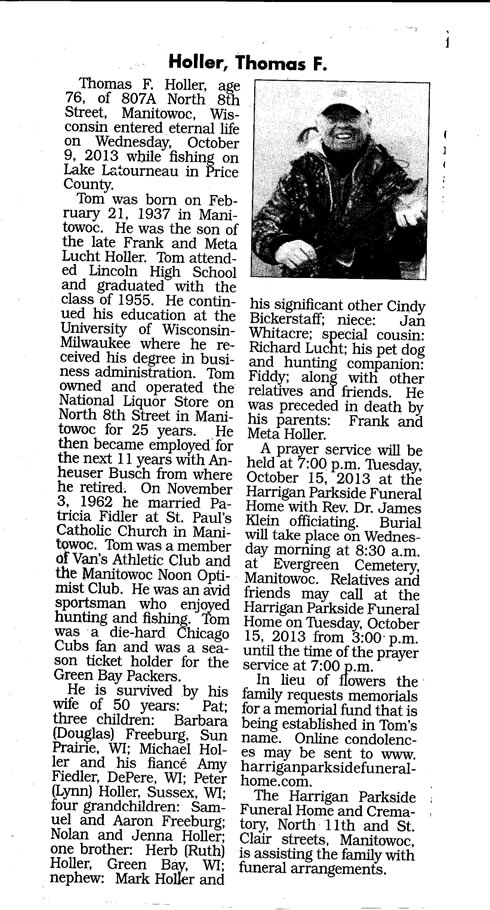
Wine Co-op 2013 in case you are interested in taking home some of the 2013 vintage.
The real time fermentation monitor graph
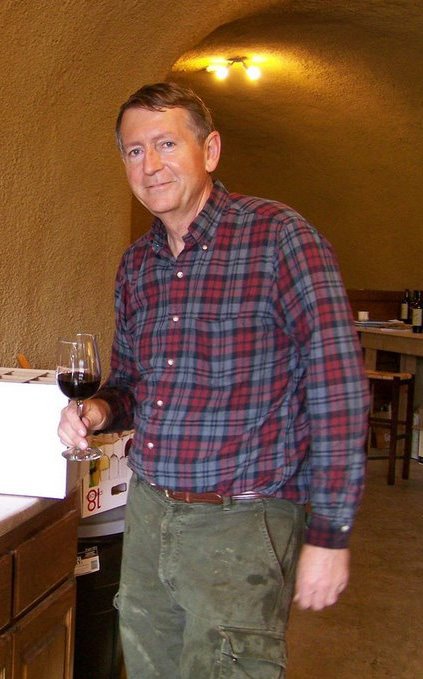
Winemaker, Mark Holler
Last Updated 9/16/13 M.H.